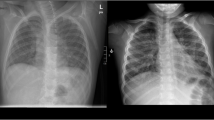Abstract
A severely ill 2-month-old female infant was admitted with meningitis and septicaemia caused byStreptococcus pneumoniae. The patient, who also had an acute cytomegalovirus (CMV) infection, revealed the typical clinical and biochemical characteristics of type I tyrosinaemia (TIT). Clinical evidence of severe hepatocellular damage was shown, but urinary succinylacetone was not detected. The diagnosis of TIT was finally confirmed by decreased activity of fumarylacetoacetase (FAA) in skin fibroblasts from the patient and both parents. Following dietary treatment and after overcoming the bacterial and viral infection, the patient's liver function improved.
Similar content being viewed by others
Abbreviations
- CMV:
-
cytomegalovirus
- FAA:
-
fumarylacetoacetase
- TIT:
-
type I tyrosinaemia
References
Bain MD, Purkiss P, Jones M, Bingham P, Stacey TE, Chalmers RA (1990) Dietary treatment eliminates succinylacetone from the urine of a patient with tyrosinemia type 1. Eur J Pediatr 149:637–639
Berger R, Faassen H van, Smit GPA (1983) Biochemical studies on the enzymatic deficiencies in hereditary tyrosinemia. Clin Chim Acta 134:129–141
Bodegard G, Grentz J, Lindblad B, Lindstedt S, Zetterström R (1969) Hereditary tyrosinemia III. On the differential diagnosis and the lack of effect of early dietary treatment. Acta Paediatr Scand 58:37–48
Christensen E, Jacobsen B, Gregersen N, Hjeds H, Pedersen JB, Brand NJ, Baekmark UB (1981) Urinary excretion of succinylacetone and δ-aminolevulinic acid in patients with hereditary tyrosinemia. Clin Chim Acta 116:331–341
Church JA, Koch R, Shaw KNF (1984) Immune functions in methylmalonic aciduria. J Inherited Metab Dis 7:12–44
Cowan MJ, Packman S, Wara DW (1974) Multiple biotindependent carboxylase deficiencies associated with defects in T-cell and B-cell immunity. Lancet 21:115–118
Fällström SP, Lindblad B, Lindstedt S, Steen G (1979) Hereditary, tyrosinemia-fumarylacetoacetase deficiency. Pediatr Res 13:78
Grenier A, Lescault A, Laberge C, Gagné R, Mamer O (1982) Detection of succinylacetone and the use of its measurement in mass screening for hereditary tyrosinemia. Clin Chim Acta 123:93–99
Halvorsen S, Kvittingen EA, Flatmark A (1988) Outcome of therapy of hereditary tyrosinemia. Acta Paediatr Jpn 30:425–428
Jacobs C, Kvittingen EA, Berger R, Haagen A, Kleijer W, Nieuneijer M (1985) Prenatal diagnosis of tyrosinemia type I by use of stable isotope dilution mass spectrometry. Eur J Pediatr 144:209–210
Kvittingen EA (1986) Hereditary tyrosinemia type I—an overview. Scand J Clin Lab Invest [Suppl 184] 46:27–34
Kogut MD, Shaw KN, Donnell GN (1967) Tyrosinosis. Am J Dis Child 113:47–53
Lindblad B, Lindsted S, Steen G (1977) On the enzymic defects in hereditary tyrosinemia. Proc Natl Acad Sci USA 74: 4641–4645
Michaels K, Matalon R, Wong PWK (1978) Dietary treatment of tyrosinemia type I. J Am Diet Assoc 73:507–514
Niubo IJ, Taravilla ER, Brufan ARG, Colas MAC, Gracia JMS, Sanges JMB, Catala AG (1988) Sepsis, como forma de presentacion de tirosinemia hereditaria tipo I. An Esp Pediatr 29:235–238
Savigny D de, Voller MA (1980) The communication of Elisa data from laboratory of clinician. J Immunoassay 1:105–128
Scriver CR, Larochelle J, Silverberg M (1967) Hereditary tyrosinemia and tyrosyluria in a french Canadian geographic isolate. Am J Dis Child 113:41–46
Slørdahl S, Lie So, Jellum E, Stokke O (1979) Increased need forl-cysteine in hereditary tyrosinemia. Pediatr Res 13:74
Stoner E, Starkman H, Wellner D, Wellner VP, Sassa S, Rifkind AB, Grenier A, Steinherz PG, Meister A, New MI, Levine LS (1984) Biochemical studies of a patient with hereditary hepatorenal tyrosinemia: evidence of glutathione deficiency. Pediatr Res 18:1332–1336
Tada K, Wada Y, Yazaki N, Yokoyama Y, Nakagawa H, Yoshida T, Sato T, Arakawa T (1968) Dietary treatment of infantile tyrosinemia. Tohoku J Exp Med 95:337–344
Thoene J, Sweetman L, Shafai T, Kennaway N, Fellman J and Nyhan W (1978) Tyrosinemia associated with perinatal infection with cytomegalovirus. J Pediatr 92:108–112
Wadman SK, Duran M, Ketting D, Bruinvis L, van Sprang FJ, Berger R, Smit GPA, Steinmann B, Leonard JV, Divry P, Farriaux JP, Cartigny B (1983) Urinary excretion of deuterated metabolites in patients with tyrosinemia type I after oral loading with deuteratedl-tyrosine. Clin Chim Acta 130:231–238
Yu JS, Walker-Smith JA, Burnhard ED (1971) Neonatal hepatitis in premature infants simulating hereditary tyrosinosis. Arch Dis Child 46:206–309
Author information
Authors and Affiliations
Rights and permissions
About this article
Cite this article
Wabitsch, M., Pohlandt, F., Leupold, D. et al. Clinical features and diagnostic approach in type I tyrosinaemia in an infant with cytomegaly virus infection and bacterial sepsis. Eur J Pediatr 152, 327–330 (1993). https://doi.org/10.1007/BF01956746
Received:
Accepted:
Issue Date:
DOI: https://doi.org/10.1007/BF01956746




